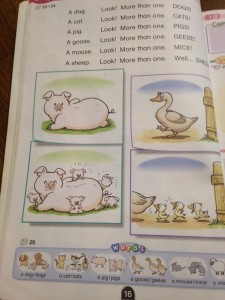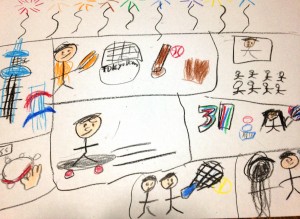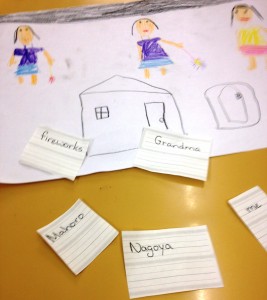

- 54. 10 Useful Pieces of Advice for Teaching with LEARNING WORLD #9 & 10
- 55. “Happy New Year!” “I don’t say that.”
- 53. Halloween 2019
- 52. READY Workbook Pg. 17
- 51. English-Uplift 1-Day Seminars
- 50. READY Workbook - vocabulary copying activity
- 49. 10 Useful Pieces of Advice for Teaching with LEARNING WORLD #8
- 48. 10 Useful Pieces of Advice for Teaching with LEARNING WORLD #7
- 47. 10 Useful Pieces of Advice for Teaching with LEARNING WORLD #6
- 46. 10 Useful Pieces of Advice for Teaching with LEARNING WORLD #5
- 45. 10 Useful Pieces of Advice for Teaching with LEARNING WORLD #4
- 44. 10 Useful Pieces of Advice for Teaching with LEARNING WORLD #3
- Kindergarten aged students
- Lower Elementary-school aged students
- Upper Elementary-school aged students
- Junior High and older students
- Others
6. A dog! Look! More than one… DOGS!
Page 7 of Learning World Book 3 reminds students of the plural “s” for animal names, as well as introduce new plural forms for animal names that are an exception to the rule: “mouse… mice”, “goose… geese” and “sheep… sheep”.
For a long time I hadn’t really thought about when in English we actually use the plural form for animals aside from as vocabulary for “I like …” However recently the SPRINGBOARD Level 5 book “Kangaroos” gave me some inspiration.
The story inside the book gives some basic facts about kangaroos:
“Kangaroos have a pouch.”
“Kangaroos have a strong tail.”
“Kangaroos can hop.”
“Kangaroos eat grass.”
Using this book as a base, I wondered if my class of 5th graders (minimum of 3 years experience and currently on LW Bk3) would enjoy brainstorming and writing some basic facts about the animals on page 7.
In class, after reading “Kangaroos” together, they decided that:
“Dogs can run”, “Dogs can jump”, “Dogs like balls” and “Dogs like running”.
With class time coming to a close, I asked them to complete “Cats”, “Pigs”, “Mice” and “Geese” for homework. When they presented me with their completed homework the following week, I was very surprised at their ideas:
“Cats eat nori” is this student’s personal observation of his family pet.
His idea “Sheep don’t like dogs” is inspired by another SPRINGBOARD story “Pet Dogs and Working Dogs” (Level 6).
The source of his idea “Mice eat grass” is unknown, but it’s an idea he insists is factual.
This student’s English has in this photo not yet been corrected, but her idea “Geese have teeth” is based on a search on the Internet. I wasn’t aware that geese had teeth!
Expanding a textbook idea to the point where students’ originality can surprise you is actually quite nice, isn’t it?
4. What did you do in your summer vacation?
Every year at this time I’m always frustrated by my inability to create an interesting ”What-did-you-do-in-your-summer-vacation” lesson. The difficulty with these types of post-vacation lessons is that the content depends entirely on the students, and no two vacation experiences are exactly the same.
It’s not easy to have beginner students speak in English about their summer vacation in a meaningful way because they lack a lot of the vocabulary and expressions that they need in order to do so.
Perhaps “I went to ~” is a nice and simple expression to build a lesson around, because most students went somewhere – often to interesting, faraway places. But then what do you do with those students who are convinced that they absolutely didn’t go anywhere? A lesson involving “I went to ~” lesson requires all the students to have gone somewhere in order for the lesson to work, so we as the teacher simply decide for some unlucky and understandably unenthusiastic students that they have to say “I went to the park” or “I went to the supermarket” just so that the lesson can proceed as smoothly as possible…
And within such a lesson, even when students have announced “I went to Guam”, the more interesting information about what they saw, ate, and did there isn’t forth-coming.
Again this year, I’ve been confronting these frustrations – and to my surprise, I’ve been getting a fair amount of positive results with this year’s lesson idea. So it might be worth sharing with you here.
I realize of course that by the time you read this, your “summer vacation” lessons are probably finished, and you’re well back into your textbook. However, winter is not far off. The same idea can very well be applied to winter vacation.
This idea involves: drawing, speaking, simple one-word reading, simple one-word writing (i.e copying), gluing and individual presentation to the class; it’s suitable I believe for your elementary school students, and younger students with experience.
●STEP 1: On A4 paper, have students draw a picture/pictures of their summer vacation.
Allow a good amount of class time for this – perhaps 10~20 minutes. The more time you allow, the more ideas students can express.
●STEP 2: Some students will finish before others. Take students who have completed their drawings aside on an individual basis – a couple of minutes each – and get information from them about what they drew. Make notes for your reference.
These notes were made during each brief conversation I had with each student. You can see the students’ names and their answers to such questions as “What did you draw?” “What’s this?” “Where is this?” “Who is this?” “Is this ~?” Get as much information from each picture as possible.
It’s important that your conversation with each student is done away from other students because:
– you don’t want other students to get too many details on their classmates’ vacation just yet.
– some students may express less information if they know other students are listening to their conversation with you.
●STEP 3: Once all students have completed their pictures and have spoken to you in private about their drawing, have them present their drawing to the class.
The conversation they had with you in private should be enough practice for students to present the content of their summer vacation to the class. Encourage other students to ask questions – the same questions you did: “What’s this?” “Who’s this?” etc.
●STEP 4: Write all of your notes of your earlier conversations with students onto 4-line paper – with a free line for students to copy your handwriting.
Depending on the size of your class, you may need to complete this step during your preparation for the next lesson. That’s OK. This activity idea can be spread over two lessons.
●STEP 5: Scatter the paper on the floor. Students need to find their papers, and bring each one to you for confirmation with the English “Is this my paper?”
The written English is English that the students produced for you during your conversation. Students with even the most basic phonics experience should be able to find their papers without the need for help.
●STEP 6: Students copy the English on their papers, cut away your English with scissors, then glue their English onto their pictures.
●STEP 7: Students present their summer vacation pictures to the class one more time, this time reading the English that they wrote and glued.
I found this activity positive because:
- it can cater for all the students, regardless of their experience.
- it can cater to a variety of vacations. Students don’t necessarily need have “gone” somewhere.
- it involves a variety of skills.
- it involves student-to-class presentation.
By all means, give it a try after the winter break!
















 ←Click to enlarge
←Click to enlarge ←Click to enlarge
←Click to enlarge


















